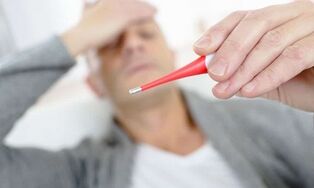Prostatitis is a prostatitis, usually diagnosed in elderly men. The initial or initial symptoms of prostatitis are very specific, which makes it possible to find the pathology in time, conduct a comprehensive examination and start treatment.
Type of disease and initial symptoms

The disease has two forms-bacterial (infectious) prostatitis and non-bacterial congestive prostatitis. The first signs of disease directly depend on the nature of inflammation.
In the first case, the cause of the disease is infection, usually caused by the action of sexually transmitted bacteria. This form of prostatitis is characterized by the ascending or descending route of prostate infection-the infection enters through the urethra or from the kidneys. Symptoms of inflammation are acute, increase rapidly, and often fever.
Non-infectious prostatitis is a disease of office workers and men over 50. The disease develops due to hyperemia in the pelvic area. The cause of inflammation is the violation of the blood microcirculation in the prostate, the stagnation of secretions in the organs and the violation of the nutrition of the prostate tissue. This form of inflammation is characterized by a slow increase in symptoms, usually a latent course. If happiness deteriorates rapidly in the bacterial form of the disease, non-infectious prostatitis is rarely troubled at an early stage, which makes it difficult to diagnose the disease in time.
Common symptoms of prostatitis
Regardless of the form of the disease, the symptoms of male prostatitis are as follows:
- Pain when urinating;
- Anal discomfort;
- Incomplete bladder emptying;
- Decreased urine pressure;
- Often urged to go to the toilet at night;
- General discomfort;
- Reduced erection;
- Violation of reflection;
- Pain during ejaculation.
It is impossible to answer the question of how prostatitis itself behaves in the initial stage. Each patient has different symptoms in the early stages of disease development. This is due to the characteristics of the organism.
In most cases, the initial symptoms of prostatitis are anal discomfort and light excretion during urination. This symptom indicates inflammation of the organ.
Usually, men’s erectile ability is weakened, and other symptoms of the initial form of inflammation may disappear completely. The problem is that patients rarely go to the doctor for problems with ejaculation problems or decreased erectile function. Usually, neglect of one's own health over time can lead to progressive prostatitis, which is difficult to treat.
Pain during urination and frequent urge to go to the toilet are caused by the pressure of organ inflammation. This leads to narrowing of the urethral cavity and incomplete bladder emptying. Often, significant urination problems are noted in the second stage of the disease rather than the first stage.
Specific symptoms

Specific signs are characteristic symptoms of various forms of inflammation. For the bacterial form of this disease, please note:
- Increased body temperature;
- Excreted from the urethra; Blood in urine;
- Stinging and burning after urinating.
Usually, patients experience severe pain at the end of urination. Blood is usually released, or yellowish or purulent discharge is observed. Such signs are characteristic of bacterial inflammation, especially caused by diseases transmitted by unprotected sex. The temperature may rise more than 38°C. There are also symptoms of body poisoning, general weakness and decreased physical strength. Usually, due to bacterial inflammation, the temperature will rise first, and some special symptoms will appear after a few days, such as pain when urinating and frequent urination.
Elevated temperature is characteristic of the bacterial form of prostatitis.
Initial symptoms and manifestations of the non-infectious form of the disease:
- Pressure and swelling of the anus;
- Decreased urine pressure;
- Erectile dysfunction;
- Often urged to urinate, especially at night.
In this case, the temperature rarely rises and there are no symptoms of poisoning. Perineal pain did not develop. In the initial stage of non-infectious prostatitis, there will always be discomfort in the anus, which is caused by the increase in the size of the inflamed organ.
Due to the increased frequency of urination at night, patients often complain of insomnia and energy loss. In this case, stress and neurosis may occur.
Rare non-specific symptoms
Prostatitis refers to diseases with specific symptoms. In most cases, these diseases are enough to perform a digital examination of the prostate and make a diagnosis. The non-specific manifestations of prostatitis are caused by clinical cases, and this disease develops under certain major pathological backgrounds.
Therefore, prostatitis with prostate stones as the background is rarely diagnosed, but in this case, the typical symptoms are blood in the urine and the release of water droplets in the urethra during urination.
In genital infections, prostatitis can be accompanied by severe pain and purulent discharge in the perineum.
One of the most difficult forms of disease to diagnose is fungal prostatitis. The disease develops against the background of systemic mycosis or chronic candidal balanitis. The typical symptoms are inflammation of the glans penis, the formation of dense white patches and pain during urination. In addition, anal pain and genital itching may occur.
Congestive prostatitis may have discharge after urination. In this case, a small amount of mucus, pus or blood will be released. Usually, if there is a discharge, there are no symptoms other than discomfort after urination.
When to see the doctor?
It is important to understand that the initial stage of prostatitis can be successfully cured, while chronic pathological forms require long-term medication. Treatment in this case can last for several years.
The reason for going to a urologist is:

- Urination disorders;
- Changes in the nature of erection;
- Foreign body in semen; Water droplets in urine;
- The anus is full.
It is recommended that all men over the age of 40 see a urologist every year. In the past few decades, prostatitis has been significantly "younger". Now, the initial symptoms and manifestations of this disease are increasingly appearing in men aged 25-30. Office workers, overweight patients and all sedentary people experience the first signs of illness.
Therefore, the first thing to do in the early detection of prostatitis is to conduct a comprehensive examination, which includes:
- Finger examination organ (prostate massage);
- Ultrasound of prostate, kidney and bladder;
- Blood test to determine PSA level;
- Bacterial semen analysis;
- Microscopic examination of prostate secretions.
The stage of the disease can be identified by the photo (ultrasound) of the prostate. Based on these diagnostic methods, doctors can determine the stage of inflammation and choose the best treatment plan.
Principles of treatment of prostatitis
When the first symptoms of prostatitis are detected, the choice of treatment depends on the form of the disease. Usually, specific symptomatic treatment is performed.
Specific processing methods include:
- Prostate protectant;
- antibiotics;
- alpha-blockers;
- restorer;
- Diet and lifestyle adjustments.
Prostate protector is a medicine to improve the nutrition of prostate tissue. For treatment and prevention purposes, prescription drugs are used for any form of prostatitis.
Antibiotics are suitable for bacterial inflammation. They were drunk for a long time-up to a month and a half. In some cases, fluoroquinolones can be used instead. In the treatment of non-infectious prostatitis, non-steroidal anti-inflammatory drugs are used.

Alpha blockers are drugs that relax the muscles of the bladder and prostate. Drugs taken in this group are intended to promote the urination process.
The enhancer used to treat prostatitis is a variety of herbal preparations, including medicinal preparations and folk preparations. These tools include:
- Pumpkin extract candle;
- Pumpkin seed oil;
- Rectal suppositories with propolis;
- Echinacea tincture;
- Herbal preparations;
- film.
The use of these funds has nothing to do with the form of inflammation at any stage of the disease.
Symptomatic treatment includes appointment:
- Antispasmodic;
- Antipyretic;
- Analgesics;
- Non-steroidal anti-inflammatory drugs;
- Sedatives.
Antispasmodics can help relieve urination in the early stage of prostatitis. When the temperature rises to the background of bacterial inflammation, antipyretics should be used. Analgesics help relieve pain. Non-steroidal anti-inflammatory drugs have analgesic and anti-inflammatory effects, so they are usually prescribed for non-infectious prostatitis. According to the doctor's instructions, sedatives can be recommended to the patient. They stipulate that insomnia and stress caused by insomnia and stress are caused by discomfort and frequent use of the toilet.
Possible complications
Any disease is easier to treat at an early stage, and prostatitis is no exception. Timely treatment can not only eliminate discomfort and pain, but also significantly improve men's quality of life and sexual activity.
Emitted prostatitis is a chronic disease, full of many complications, including:

- Acute stagnation of urine;
- Kidney infection;
- Infertility;
- Yang imp.
The chronic form of the disease requires continuous medication to restore a person's health to normal. For many years, medical treatments were usually ineffective, and then the only way to normalize the patient's condition was surgical intervention-partial or complete removal of the organ.
The initial stage of prostatitis lasts about three to four years. Then, the disease became chronic. After understanding the initial symptoms of male prostatitis and the treatment of the initial disease, you should consult a specialist as soon as possible. Prostatitis is not a disease diagnosed by photos, because the disease has no visible manifestations. In order to detect the first symptoms in time, you should listen to your health.






























